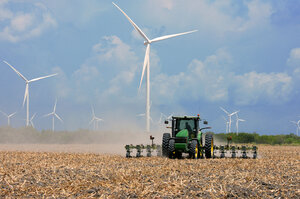How small farmers are adapting to climate change
Everyone must play a role in helping small farmers adapt to climate change, and chefs are uniquely positioned to do so. Recipes for change, a campaign of the International Fund for Agricultural Development (IFAD), features ingredients that are under threat from climatic changes.

A farmer plows his recently harvested field as the hot summer sun beats down on Monday, Aug. 17, 2015 in the agricultural area north of Rio Hondo, Texas.
Jason Hoekema/Valley Morning Star/AP/File
2014 was the hottest year on record, according to both the Intergovernmental Panel on Climate Change (IPCC) and the National Ocean and Atmospheric Administration (NOAA). Rainfall in crucial agricultural zones is diminishing, and small farmers are facing desertification of farmland due to climate change. Everyone must play a role in helping small farmers adapt to climate change, and chefs are uniquely positioned to partner with the farmers who grow the ingredients for their meals. Recipes for Change, a campaign of the International Fund for Agricultural Development (IFAD), features ingredients that are under threat from climatic changes.
The campaign focuses on traditional crops and dishes that are under threat from global climate change. Regional celebrity chefs travel to rural areas to work with small farmers and to cook traditional meals with local farmers. A series of videos features stories and recipes from rural communities in Africa, Asia, and Latin America, and also features celebrity chefs from those regions. IFAD, a specialized agency of the United Nations, has partnered with the Research Program on Climate Change, Agriculture, and Food Security(CCAFS) to produce the videos.
The project notes that one in three people are dependent on smallholder farms for food security. Furthermore, small farmers often produce food on marginal land and face reduced yields and incomes due to climate change. Therefore, adaptation to climate change is of vital importance to small farmers and rural communities.
Videos include recipes for sweet and sour catfish soup from Vietnam, bananas with beans and split green peas from Rwanda, and Chairo soup from Bolivia. Other recipes, such asPoulet Yassa from Senegal and Guatemalan rice and beans, are also available; the online recipes explain both regional climate risks and IFAD solutions to problems faced by smallholder farmers.
In celebration of World Environment Day 2015, Italian celebrity chef Carlo Cracco visitedMoroccan farmer Fatima Abed to create a recipe for lamb tagine with Moroccan truffles. Abed is facing desertification and land degradation due to climatic changes. “Coming here is a humbling experience because if you let it, the desert will advance,” said Cracco. “We must help those people who work to recuperate the land, so that there is a change in the way we fight the battle of climate change.”
Leading up to the Conference of the Parties (COP21) in December of 2015, IFAD will intensify the campaign in hopes of contributing to a worldwide call for an ambitious global deal on climate change. Many other organizations are showing support and solidarity for small farmers adapting to climate change by organizing actions and campaigns worldwide.
Recipes For Change grew out of IFAD’s existing work with small farmers and adaptation to climate change. IFAD’s Adaptation for Smallholder Agriculture Programme (ASAP) channels climate finance to small farmers to build resilience in the face of climate risks. Working in more than 30 developing countries, ASAP is now the largest global financing source related to adaptation to climate change.
Join the community and discuss ingredients and issues with other changemakers! Follow Recipes for Change on Twitter and Instagram: #RecipesForChange

